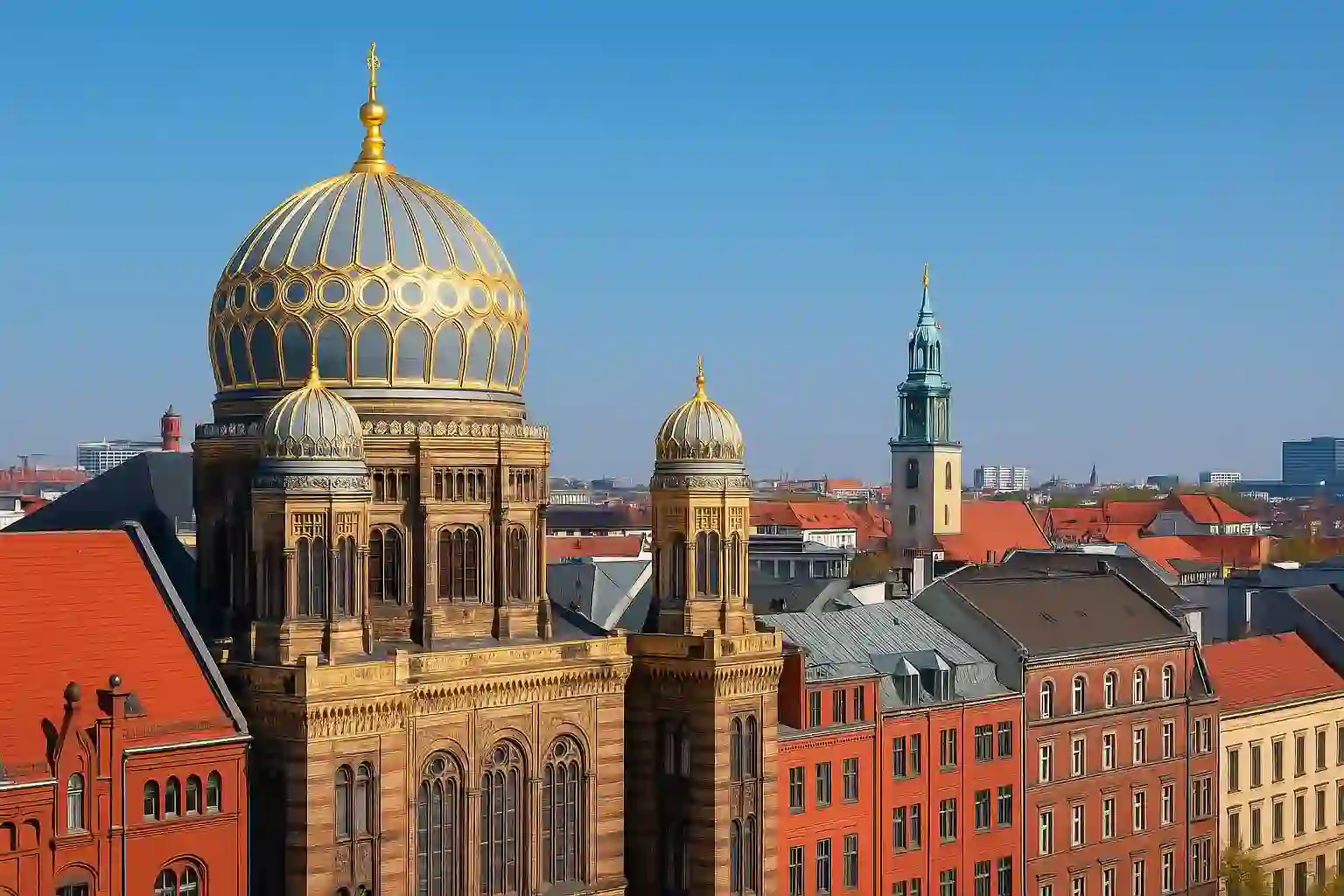New Synagogue Berlin – Jewish Community Tour
The New Synagogue Berlin – Jewish Community Tour invites you to explore one of the city’s most iconic Jewish landmarks. Discover the rich history, cultural resilience, and architectural beauty of this historic site in the heart of Berlin.

Nazi Berlin and the Jewish Community Tour
Join a guided walk through Berlin’s historic Jewish quarter and the former Nazi headquarters. This in-depth tour explores traces of Jewish life, stories of resistance, and the legacy of persecution under the Third Reich.
Architecture & Historical Background
The New Synagogue Berlin, inaugurated in 1866, once served as the main synagogue for the city’s thriving Jewish community. Designed by Eduard Knoblauch and completed by Friedrich August Stüler, it was inspired by Moorish architectural elements – especially those of the Alhambra in Granada.
Its golden dome, oriental-style façade, and elaborate interior reflected the confidence of Jewish emancipation in the 19th century. The building was partially destroyed during Kristallnacht in 1938 and further damaged in World War II bombings.
Today, the restored front section serves as a museum and a place of remembrance, while the dome remains one of the most iconic symbols of Jewish heritage in Berlin.
Did you know?
The golden dome of the New Synagogue once stood as a shining symbol of Jewish life in Berlin. Inaugurated in 1866, it was Germany’s largest synagogue at the time, with over 3,000 seats. During the Nazi pogrom of 1938, a brave police officer managed to stop it from being completely destroyed. Today, the partially reconstructed building serves as both a memorial and a testament to the resilience of Jewish heritage.
Opening Hours & Admission
| Day | Opening Hours |
|---|---|
| Monday | Closed |
| Tuesday – Sunday | 10:00 – 18:00 |
Admission Prices:
- Adults: €8
- Reduced: €5 (students, seniors)
- Children under 6: free
- Family ticket: €15
Map: New Synagogue Berlin & Nearby Highlights
Discover the historical Jewish quarter of Berlin – including the iconic New Synagogue and several nearby landmarks.
Frequently Asked Questions: New Synagogue Berlin
Is the dome of the New Synagogue Berlin made of real gold?
What is the full route of the Jewish Community Tour?
When does the Jewish community pray at the New Synagogue?
How many members belong to the New Synagogue’s congregation?
Jewish Life Today in Berlin
Beyond its historical significance, the New Synagogue stands as a symbol of Jewish life returning to the heart of Berlin. With more than 10,000 active community members, Berlin is now home to Germany’s largest Jewish population. Visitors may notice events, lectures, or cultural activities hosted by the Centrum Judaicum and other community centers throughout the city. From kosher cafés to Jewish film festivals, Berlin’s vibrant Jewish life is once again flourishing.
Architecture & Symbolism
The New Synagogue Berlin was built in the Moorish Revival style, inspired by Islamic architecture of medieval Spain. Its richly ornamented façade and oriental motifs reflect both cultural openness and Jewish heritage.
The most iconic element is the golden dome, which glistens above the Oranienburger Straße. While not made of solid gold, it serves as a visible sign of Jewish perseverance and return to public life in Berlin.
The building integrates Jewish symbols and Hebrew inscriptions into its structure, including the verse “Open the gates, that the righteous nation may enter.”
Through its architecture, the synagogue bridges tradition and modernity, memory and future. The dome today stands not just as an architectural highlight, but also as a symbol of hope.
Related Sites & Museums in Berlin
➤ Jewish Museum Berlin – Symbolic architecture and Jewish history
➤ Topography of Terror – Documentation center on Nazi terror
➤ Stolpersteine Berlin – Tracing victims of National Socialism
➤ Otto Weidt’s Workshop for the Blind – A story of resistance
➤ German Resistance Memorial Center – Honoring opposition to dictatorship
